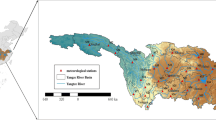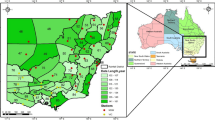Abstract
Considering the drawbacks of the original Palmer drought severity index (PDSI) in terms of its simplified hydrologic algorithm and spatio-temporal inconsistency, we compare six variants of PDSI derived from different combinations of two hydrologic algorithms and three standard processes so as to provide deep insights into the individual impacts of hydrological processing and standardization on final PDSI values as well as their combined effects. Investigations are conducted in whole Yellow River basin. On basis of 52 years’ (1961–2012) hydro-meteorological data, comprehensive analysis on multiple drought characteristics are carried out for each PDSI variant, combined with comparison of three crucial intermediate variables of PDSI. Results show that variable infiltration capacity (VIC) model based modification in the hydrologic accounting section significantly improve drought trends with more reasonable spatial distributions presented. For the statistical characteristics of drought areas and frequency, comparable performance is found between VIC-based modification and self-calibrating standard procedure-based modification, though they are derived from different mechanisms. However, in case of the coupling of these two modifications, indices derived from combined modifications perform poorly than single modification-based indices with unexpected high frequency of extreme events detected in certain regions. This reflects the complicated mechanism of PDSI and it is essential to propose an appropriate standardization to match the hydrological algorithm and further improve the performance of relevant drought index. With the crucial findings mentioned above, this study is promising to provide some theoretical supports and serve as a competent reference for future PDSI based researches.













Similar content being viewed by others
References
Allen RG, Pereira LS, Raes D, Smith M (1998) Crop evapotranspiration: guidelines for computing crop water requirements. United Nations Food and Agriculture Organization, Irrigation and Drainage Paper: 56
Alley WM (1984) The Palmer Drought Severity Index: limitation and assumptions. J Clim Appl Meteorol 23(1):1100–1109
Bartier PM, Keller CP (1996) Multivariate interpolation to incorporate thematic surface data using inverse distance weighting (IDW). Comput Geosci-uk 22(7):795–799
Cherkauer KA, Lettenmaier DP (2003) Simulation of spatial variability in snow and frozen soil. J Geophys Res Atmos 108(D22):14
Dai A (2011) Characteristics and trends in various forms of the Palmer drought severity index (PDSI) during 1900–2008. J Geophys Res 116(D12115):2010J. doi:10.1029/D015541
Dai A, Trenberth KE, Qian TT (2004) A global dataset of Palmer drought severity index for 1870–2002: relationship with soil moisture and effects of surface warming. J Hydrometeorol 5(6):1117–1130
Dumenil L, Todini E (1992) A rainfall-runoff scheme for use in the Hamburg climate model. In: Advances in theoretical hydrology, a tribute to James Dooge. Elsevier, Amsterdam
Guttman NB, Wallis JR, Hosking JRM (1992) Spatial comparability of the Palmer Drought Severity Index. Water Resour Bull 28:1111–1119
Hansen MC, Defries RS, Yownshend JRG, Sohlberg R (2000) Global land cover classification at 1 km spatial resolution using a classification tree approach. Int J Remote Sens 21(6–7):1331–1364
Karl TR (1986) The sensitivity of the Palmer drought severity index and Palmer’s Z-index to their calibration coefficients including potential evapotranspiration. J Clim Appl Meteorol 25:77–86
Kendall M (1975) Rank correlation measures. Charles Griffin, London 202
Kothavala Z (1999) The duration and severity of drought over eastern Australia simulated by a coupled ocean-atmosphere GCM with a transient increase in CO2. Environ Model Softw 14:243–252
Li QF, Li PC, Li HY, Yu MX (2014) Drought assessment using a multivariate drought index in the Luanhe River basin of Northern China. Stoch Environ Res Risk Assess. doi:10.1007/s00477-014-0982-4
Liang X, Lettenmaier DP, Wood EF, Burges SJ (1994) A simple hydrologically based model of land surface water and energy fluxes for general-circulation models. J Geophys Res 99(D7):14415–14428
Liang LQ, Li LJ, Liu CM, Lan C (2013) Climate change in the Tibetan Plateau Three Rivers Source Region: 1960–2009. Int J Climatol 33:2900–2916. doi:10.1002/joc.3642
Lohani VK, Loganathan GV (1997) An early warning system for drought management using the Palmer Drought Index. J Am Water Resour Ass 33(6):1375–1386
Ma M, Ren L, Yuan F, Jiang S, Liu Y, Kong H, Gong L (2013) A new standardized Palmer Drought Index for hydro-meteorological use. Hydrol Process. doi:10.1002/hyp.10063
Mann HB (1945) Non-parametric tests against trend. Econometrica 13:245–259
Mishra AK, Desai VR (2005) Drought forecasting using stochastic models. Stoch Environ Res Risk Assess 19:326–339
Mishra AK, Singh VP (2010) A review of drought concepts. J Hydrol 391(1–2):202–216
Mishra AK, Ines AVM, Das NN, Khedun CP, Singh VP, Sivakumar B, Hansen JW (2014) Anatomy of a local-scale drought: Application of assimilated remote sensing products, crop model, and statistical methods to an agricultural drought study. J Hydrol. doi:10.1016/-j.jhydrol.2014.10.038
Mo K (2008) Model-based drought indices over the United States. J Hydrometeorol 9(6):1212–1230
Palmer WC (1965) Meteorological drought. U.S. Department of Commerce Weather Bureau. Washington, D.C. Research Paper No. 45
Quiring SM, Papakryiakou TN (2003) An evaluation of agricultural drought indices for the Canadian prairies. Agr For Meteorol 118:49–62
Scian B, Donnari M (1997) Retrospective analysis of the Palmer drought severity index in the semi-arid Pampas region, Argentina. Int J Climatol 17(3):313–322
Sheffield J, Wood EF (2007) Characteristics of global and regional drought, 1950–2000: analysis of soil moisture data from off-line simulation of the terrestrial hydrologic cycle. J Geophys Res 112:D17115. doi:10.1029/2006JD008288
Sheffield J, Wood EF, Roderick ML (2012) Little change in global drought over the past 60 years. Nature 491:435–440. doi:10.1038/nature11575
Song S, Singh VP (2010) Meta-elliptical copulas for drought frequency analysis of periodic hydrologic data. Stoch Environ Res Risk Assess 24(3):425–444
Szép IJ, Mika J, Dunkel Z (2005) Palmer drought severity index as soil moisture indicator: physical interpretation, statistical behavior and relation to global climate. Phys Chem Earth 30(1–3):231–243
Trenberth KE, Jones PD, Ambenje P, Bojariu R, Easterling D, Tank AK, Parker D, Rahimzadeh F, Renwick JA, Rusticucci M, Soden B, Zhai P (2007) Observations: surface and atmospheric climate change. In: Solomon S, Qin D, Manning M, Chen Z, Marquis M, Averyt KB, Tignor M, Miller HL (eds) Climate change 2007: the physical science basis: contribution of Working Group I to the Fourth Assessment Report of the Intergovernmental Panel on Climate Change. Cambridge University Press, Cambridge
UNEP (1992) World atlas of desertification. The United Nations Environment Programme (UNEP), London
van der Schrier G, Jones PD, Briffa KR (2011) The sensitivity of the PDSI to the Thornthwaite and Penman–Monteith parameterizations for potential evapotranspiration. J Geophys Res 116:D03106. doi:10.1029/2010JD015001
van der Schrier G, Barichivich J, Briffa KR, Jones PD (2013) A scPDSI-based global data set of dry and wet spells for 1901–2009. J Geophys Res 118:4025–4048. doi:10.1002/jgrd.50355
Vasiliades L, Loukas A, Liberis N (2011) A water balance derived drought index for Pinios River Basin, Greece. Water Resour Manag 25:1087–1101
Vicente-Serrano SM, Beguería S, López-Moreno JI (2011) Comment on “Characteristics and trends in various forms of the Palmer drought severity index (PDSI) during 1900–2008” by Aiguo Dai. J Geophys Res 116:D19112. doi:10.1029/2011JD016410
Wang AH, Lettenmaier DP, Sheffield J (2011) Soil moisture drought in China, 1950–2006. J Clim 24(13):3257–3271. doi:10.1175/2011JCLI3733.1
Wells N, Goddard S, Hayes MJ (2004) A self-calibrating Palmer Drought Severity Index. J Clim 17(2):2335–2351
Xia J, Qiu B, Li YY (2012) Water resources vulnerability and adaptive management in the Huang, Huai and Hai river basins of China. Water Int 37(5):509–511
Xie ZH, Yuan F, Duan QY, Zheng J, Liang ML, Chen F (2007) Regional parameter estimation of the VIC land surface model: methodology and application to river basins in China. J Hydrometeorol 8(3):447–468
Xu J, Ren LL, Ruan XH, Liu XF, Yuan F (2012) Development of a physically based PDSI and its application for assessing the vegetation response to drought in northern China. J Geophys Res 117:D08106. doi:10.1029/2011JD016807
Yan DH, Shi XL, Yang ZY, Li Y, Zhao K, Yuan Y (2013) Modified Palmer drought severity index based on distributed hydrological simulation. Math Probl Eng. doi:10.1155/2013/327374
Zhang Q, Xu CY, Zhang ZX (2009) Observed changes of drought/wetness episodes in the Pearl River basin, China, using the Standardized Precipitation Index and Aridity Index. Theor Appl Climatol 98(1–2):89–99
Zhang Q, Li JF, Singh VP, Bai YG (2012) SPI-based evaluation of drought events in Xinjiang, China. Nat Hazards 64(1):481–492
Zhang BQ, Wu PT, Zhao XN, Gao XD (2014) Spatiotemporal analysis of climate variability (1971–2010) in spring and summer on the Loess Plateau, China. Hydrol Process 28:1689–1702. doi:10.1002/hyp.9724
Zhao RJ (1992) The Xinanjiang model applied in China. J Hydrol 135:371–381
Acknowledgments
This work was supported by the Special Basic Research Fund for Methodology in Hydrology (Grant No. 2011IM011000) from the Ministry of Sciences and Technology, China, the National Natural Science Foundation of China (Grant No. 41201031), the National Key Technology R&D Program by Ministry of Sciences and Technology, China (Grant No. 2013BAC10B02), the 111 Project (Grant No. B08048) from the Ministry of Education and State Administration of Foreign Experts Affairs, China, and the Fundamental Research Funds for the Central Universities of China (Grant No. 2014B35814, Grant No. 2014B35914).
Author information
Authors and Affiliations
Corresponding author
Rights and permissions
About this article
Cite this article
Liu, Y., Ren, L., Ma, M. et al. An insight into the Palmer drought mechanism based indices: comprehensive comparison of their strengths and limitations. Stoch Environ Res Risk Assess 30, 119–136 (2016). https://doi.org/10.1007/s00477-015-1042-4
Published:
Issue Date:
DOI: https://doi.org/10.1007/s00477-015-1042-4




